
Exhibited in two rows are three locomotives imported from the UK in the late 19th century and two domestic standard engines built in the early 20th century.

Exhibited in two rows are three locomotives imported from the UK in the late 19th century and two domestic standard engines built in the early 20th century.
|
By Hiroshi Naito
There are fine steam locomotives preserved in a park located in a
suburb of Tokyo, 30 km northwest of downtown Tokyo. This is Ome Railway
Park opened in 1962 in commemoration of the 90th anniversary of railway
operation in Japan. The locomotives are all on static display, but they
are precious relics that tell the history of equipment once in every
day use on rail in Japan. The park's collection includes nine steam
locomotives and one electric engine, along with one bullet train (a cab
control car of the first generation zero series).
Collections: Name Type Builder Year Built Steam Locomotives 110 110 Yorkshier, UK 1871 2221 2120 Dubs & Co, UK 1905 5540 5500 Beyer Peacock, UK 1897 8620 8620 Kisha, Japan 1911 9608 9600 Kawasaki, Japan 1913 C111 C11 Kisha, Japan 1932 C515 C51 JNR Hamamatsu Manufactory 1920 D51452 D51 Kisha, Japan 1939 E102 E10 Kisha, Japan 1948 Electric Locomotives ED161 ED16 Mitsubishi, Japan 1936 Bullet Train 22-75 0-22 Kisha, Japan 1969
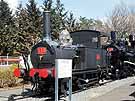 110,
2-4 tank, 22.3 tons, 7.188 m. One of ten locomotives imported from the
UK for the Japan's first railway, opened in 1872, between
Shimbashi/Tokyo and Yokohama. They were numbered #1 to #10 (this engine
is #3, but was renamed type 110 upon the 1907 nationalization). After
long term working on main line services and subsequent shunting
(switching) duties, this engine was put into storage at the national
railway's Omiya workshop, and was finally brought to this park.
110,
2-4 tank, 22.3 tons, 7.188 m. One of ten locomotives imported from the
UK for the Japan's first railway, opened in 1872, between
Shimbashi/Tokyo and Yokohama. They were numbered #1 to #10 (this engine
is #3, but was renamed type 110 upon the 1907 nationalization). After
long term working on main line services and subsequent shunting
(switching) duties, this engine was put into storage at the national
railway's Omiya workshop, and was finally brought to this park.
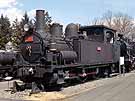 2221,
0-6-2 tank, 49.2 tons, 10.439 m. One of the most common steam
locomotives around the turn of the century in Japan. This type,
developed by R.F. Trevithick, was imported from the UK in preparation
for the 1889 full opening of the Tokaido Main Line between Tokyo and
Kobe. Due to its good traction performance based on reliable design,
this type was favorably used on main lines and secondary lines all over
Japan. The total production number of this type reached 528, which was
about a quarter of the total number of the steam engines in those days.
The builders were from not only the UK but also Germany and America.
This engine received a numbered type, 2120, but it was originally named
B6, which was carried over to later days as a nickname. After the
emergence of the powerful 9600 and D50 types, the B6s' duties declined
on the main lines, and they moved on to shunting work. However, their
powerful characteristics and capability of intense work were favored as
a shunting engine, and were seen in small-scale operations in stations
and yards all over Japan. Their long term work exceeded 70 years, and
more than a half of them survived World War 2. It was 1961 when the
last one was withdrawn from operation. It is well known that during the
Japan-Russia War many of this type were transferred to the continent to
work on war supply transportation.
2221,
0-6-2 tank, 49.2 tons, 10.439 m. One of the most common steam
locomotives around the turn of the century in Japan. This type,
developed by R.F. Trevithick, was imported from the UK in preparation
for the 1889 full opening of the Tokaido Main Line between Tokyo and
Kobe. Due to its good traction performance based on reliable design,
this type was favorably used on main lines and secondary lines all over
Japan. The total production number of this type reached 528, which was
about a quarter of the total number of the steam engines in those days.
The builders were from not only the UK but also Germany and America.
This engine received a numbered type, 2120, but it was originally named
B6, which was carried over to later days as a nickname. After the
emergence of the powerful 9600 and D50 types, the B6s' duties declined
on the main lines, and they moved on to shunting work. However, their
powerful characteristics and capability of intense work were favored as
a shunting engine, and were seen in small-scale operations in stations
and yards all over Japan. Their long term work exceeded 70 years, and
more than a half of them survived World War 2. It was 1961 when the
last one was withdrawn from operation. It is well known that during the
Japan-Russia War many of this type were transferred to the continent to
work on war supply transportation.
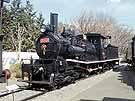 5540
Beyer Peacock, type 5500, 4-4, 29.4 tons, 14.021 m. The type 5500 was
one of the most typical locomotives used for passenger train haulage on
main lines around the turn of the century. 72 5500s were imported from
the UK in six years from 1893. As it looked speedy with sloping
cylinders below the sloping running boards, this type made rapid runs
on main line express passenger service. The type's last withdrawal from
the national railway was in 1961. A number of this type were
transferred to private railways, and some of them can be still seen at
some rail museums on display.
5540
Beyer Peacock, type 5500, 4-4, 29.4 tons, 14.021 m. The type 5500 was
one of the most typical locomotives used for passenger train haulage on
main lines around the turn of the century. 72 5500s were imported from
the UK in six years from 1893. As it looked speedy with sloping
cylinders below the sloping running boards, this type made rapid runs
on main line express passenger service. The type's last withdrawal from
the national railway was in 1961. A number of this type were
transferred to private railways, and some of them can be still seen at
some rail museums on display.
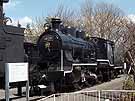 The
first member of type 8620, 2-6, 46.8 tons, 16.929 m. Type 8620 was the
national railway's first domestic standard steam locomotive and was
successfully mass-produced. This type was competitive enough in
performance of speed and traction power against imported passenger
steam engines. 687 8620s were built in the 17 years from 1914 and were
used nation-wide on secondary lines for passenger service and on
country lines for both passenger and freight service. Because of its
prevalence, it was said that Hachi-roku (nickname of the type,
eight-six in Japanese) could be seen anywhere as long as rail
continued. Some of them survived in shunting work until the end of
steam days in 1974. There is a member of this type in working order in
Kyushu. This is 58654 that hauls a steam excursion train, Aso Boy, on the Hohi Line.
The
first member of type 8620, 2-6, 46.8 tons, 16.929 m. Type 8620 was the
national railway's first domestic standard steam locomotive and was
successfully mass-produced. This type was competitive enough in
performance of speed and traction power against imported passenger
steam engines. 687 8620s were built in the 17 years from 1914 and were
used nation-wide on secondary lines for passenger service and on
country lines for both passenger and freight service. Because of its
prevalence, it was said that Hachi-roku (nickname of the type,
eight-six in Japanese) could be seen anywhere as long as rail
continued. Some of them survived in shunting work until the end of
steam days in 1974. There is a member of this type in working order in
Kyushu. This is 58654 that hauls a steam excursion train, Aso Boy, on the Hohi Line.
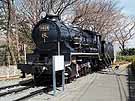 9608,
type 9600, 2-8, 60.4 tons, 16.662 m. This type also became the national
railway's domestic standard steam locomotives and was regarded as the
8620's counterpart in freight haulage. As opposed to 8620's Hachi-roku
(eight-six), this type was dubbed Kyu-roku (nine-six). The 9600's most
nortable feature was its boiler arranged at a higher position that
allowed a widened firebox put above the traction wheels, which was
effective in reinforcing traction power. With its powerful haulage
performance, this type greatly contributed to dealing with the
increasing demands of freight transportation in those days. 770 of this
type were built through mass-production with the first batch started in
1913 and they were seen all over Japan in freight service. This type
was also used in Taiwan and Sakhalin. An interesting fact is that
Taiwan's 17 9600s were produced by Alco in the US, because domestic
manufacturers were busy with orders made by national railways. This is
the only locomotive type designed by a Japanese railway and produced in
a foreign country.
9608,
type 9600, 2-8, 60.4 tons, 16.662 m. This type also became the national
railway's domestic standard steam locomotives and was regarded as the
8620's counterpart in freight haulage. As opposed to 8620's Hachi-roku
(eight-six), this type was dubbed Kyu-roku (nine-six). The 9600's most
nortable feature was its boiler arranged at a higher position that
allowed a widened firebox put above the traction wheels, which was
effective in reinforcing traction power. With its powerful haulage
performance, this type greatly contributed to dealing with the
increasing demands of freight transportation in those days. 770 of this
type were built through mass-production with the first batch started in
1913 and they were seen all over Japan in freight service. This type
was also used in Taiwan and Sakhalin. An interesting fact is that
Taiwan's 17 9600s were produced by Alco in the US, because domestic
manufacturers were busy with orders made by national railways. This is
the only locomotive type designed by a Japanese railway and produced in
a foreign country.
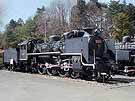 C51
5, type C51, 4-6-2 Pacific, 69.6 tons, 19.2 m. This type was the
national railway's second-generation domestic standard steam locomotive
following the 8620 and 9600. The C51 was developed to respond to the
demands for more powerful passenger locomotives under the situation of
increasing passenger traffic resulting from the booming economy just
after World War 1. The C51 5 was built in 1919 at the national
railway's Hamamatsu Workshops. 289 C51s were produced by 1928. In
contrast to the first Pacific, type 8900, imported from the US, the C51
was superior in every aspect of performance. Meanwhile, this type
superseded all the 8900s on the Tokaido Main Line in express passenger
work. The most remarkable feature of the C51 was its 1,750 mm traction
wheels, which could be favorably compared to locomotives on standard
gauge.
C51
5, type C51, 4-6-2 Pacific, 69.6 tons, 19.2 m. This type was the
national railway's second-generation domestic standard steam locomotive
following the 8620 and 9600. The C51 was developed to respond to the
demands for more powerful passenger locomotives under the situation of
increasing passenger traffic resulting from the booming economy just
after World War 1. The C51 5 was built in 1919 at the national
railway's Hamamatsu Workshops. 289 C51s were produced by 1928. In
contrast to the first Pacific, type 8900, imported from the US, the C51
was superior in every aspect of performance. Meanwhile, this type
superseded all the 8900s on the Tokaido Main Line in express passenger
work. The most remarkable feature of the C51 was its 1,750 mm traction
wheels, which could be favorably compared to locomotives on standard
gauge.
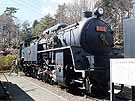 E10
2, type E10, 2-10 tank, 102.1 tons, 14.5 m. This is the last steam
engine developed and the heaviest in Japan. Five E10s were built in
1948 for banking work on the Ou Main Line's 3.3% grading segment
between Fukushima and Yonezawa. The segment was electrified one year
later, and they were transferred to Kyushu island to work on a similar
duty on the Hisatsu Line. The E10 was not particularly powerful
compared to the popular D51, so they were transferred to banking work
on the Hokuriku Main Line across the Kurikara Pass near Kanazawa. The
gradient along the Pass was soon improved by track reconstruction, so
they lost their job again, and were finally put to use on short
connection work between Maibara and Tamura on the Hokuriku Main Line,
which linked DC and AC electrification. They ended their unluckily
short lives in 1967. Interestingly, the E10 utilised flangeless wheels
on the third and forth axles to make it possible to round a sharp curve.
E10
2, type E10, 2-10 tank, 102.1 tons, 14.5 m. This is the last steam
engine developed and the heaviest in Japan. Five E10s were built in
1948 for banking work on the Ou Main Line's 3.3% grading segment
between Fukushima and Yonezawa. The segment was electrified one year
later, and they were transferred to Kyushu island to work on a similar
duty on the Hisatsu Line. The E10 was not particularly powerful
compared to the popular D51, so they were transferred to banking work
on the Hokuriku Main Line across the Kurikara Pass near Kanazawa. The
gradient along the Pass was soon improved by track reconstruction, so
they lost their job again, and were finally put to use on short
connection work between Maibara and Tamura on the Hokuriku Main Line,
which linked DC and AC electrification. They ended their unluckily
short lives in 1967. Interestingly, the E10 utilised flangeless wheels
on the third and forth axles to make it possible to round a sharp curve.
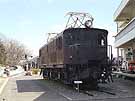 ED161,
type ED16, 1-Bo-Bo-1. This is the first domestically made electric
locomotive as a standard mid-sized engine. This type of locomotive was
mainly used on the Chuo Line and Joetsu Line. They were all withdrawn
by the mid-1980s.
ED161,
type ED16, 1-Bo-Bo-1. This is the first domestically made electric
locomotive as a standard mid-sized engine. This type of locomotive was
mainly used on the Chuo Line and Joetsu Line. They were all withdrawn
by the mid-1980s.